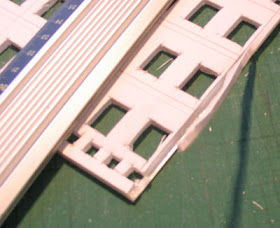I
used foamboard (foamcore) to produce some 15mm buildings for my Stalingrad project.
Many wargames use templates for built-up areas. The buildings are purely aesthetic and
are moved around or even removed when the areas are occupied by troops. For
Crossfire I wanted some multi-storey structures with individual footprints of
about 4"/100mm into which elements (representing squads) could actually be placed.
I bought some readymades but I also decided to make some ruined and semi-ruined
buildings from foamboard. There are lots of good articles on the Web to which
I am indebted. This is just an account of my personal approach. Foamboard has
a layer of foam sandwiched between two layers of card and can be bought in 3mm
and 5mm thicknesses from art shops for as little as £2 for an A3 sheet. After
some experiment, I developed the following procedure.
Design the buildings
on a computer. I use CorelDraw and allow a basic height of 30mm per storey for
15mm scale. Print
out the designs and trim to size with scissors. Stick the print-outs to
the foamboard using Spraymount. The model illustrated is actually a double
unit (4" x 8").
Cut with a sharp scalpel using a non-slip metal rule and a 'magic mat'. It's best to cut out all the windows before separating the parts. Keep the cutouts. Each window and each gap between windows is 10mm wide. The gap between the end windows and the corners is 5mm. This makes it easy to produce multiple unit structures without changing the basic design.
Rabbet
the corners. This strengthens them and hides the foam.
Stick
the parts together with a liberal amount UHU glue and reinforce with long (30mm) dressmaking
pins. You can now buy a type of UHU friendly to expanded polystyrene. The upper floors have holes cut for stairwells. This is partly for realism (a concept I don't take too far) and partly to make it easier to see the figures inside.
Mount the structures on MDF to give some added strength and weight at the base. My MDF bases are precut to 100mm x 100mm and the structures fit within these measurements. Two bases are used here to create a double-sized structure. Stick offcuts in the corners for reinforcement and to form the basis of piles of rubble...
The top floor is given some extra damage. Partition walls are added for strength and to divide the structure into two Crossfire building zones, forming a building complex under the rules. The upper floor should probably show more signs of damage, but it needs to retain enough surface to support a couple of figure elements. The completed structure consumed about three-quarters of an
A3 sheet. It's loosely based on the Stalingrad Mill, now preserved
as a public monument.
Here I've added window sills from matchsticks and stuck on patches of embossed brick-patterned plastic sheeting to represent exposed bricks. There are two good options for cutting matchsticks IMHO: (1) a razor saw and mitre, or (2) a plastic matchstick cutter which chops them. I found a scalpel was not a good option.
The saved cut-outs are chopped up with an old pair of scissors to
represent rubble.
Balsa and matchstick scraps are added to the diced foamboard and thrown into the corners after dabbing these with PVA. Whatever sticks, stays. (The picture shows another building).
The cat litter goes in to add a bit of crumbled, broken up rubble. I've worked with sand before, but not cat litter. I was impressed by how effective it looks.
Balsa and matchstick scraps are added to the diced foamboard and thrown into the corners after dabbing these with PVA. Whatever sticks, stays. (The picture shows another building).
The building is coated overall with a mixture of PVA and Tetrion/Polyfilla,
leaving the brickwork showing as if the stucco has come away. Unfortunately
the coating is thinner than the plastic card, so I had to apply
several coats so that the stucco appears to overlap the bricks rather
than the other way round. I now realise why Nikolas Lloyd adds a
layer of blotting paper! (Tissue soaked in PVA can also be used). At
first I thought the coating looked rather thick and lumpy, but it
seemed to smoothen when it dried (and the PVA shrunk?). Once it
hardened the structures becomes considerably stronger.
The cat litter goes in to add a bit of crumbled, broken up rubble. I've worked with sand before, but not cat litter. I was impressed by how effective it looks.
The mill is towards the top left corner. The buildings were spray-painted with white undercoat and
then given pastel washes. Exposed brick and brick rubble was
painted red. After picking out detail, they were given black
washes to represent smoke damage. I didn't bother with
chimney stacks which would of course have been present in
buildings of this period.
You can download a sample building template in PDF format here.
You can download a sample building template in PDF format here.













Great job! Currently working on my Stalingrad buildings and your blog is an insperation!
ReplyDeleteThanks!
Troy
Hi Troy
ReplyDeleteThanks for your very flattering comment. There is some very nice work shown on your own blog!
Amazing work!
ReplyDeleteHi Rubble Rouser and welcome as a follower.
ReplyDeleteThat's a generous comment coming from a master builder such as yourself!